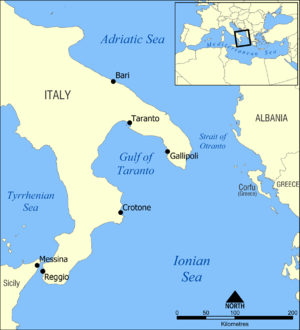Strait of Otranto
| Strait of Otranto | |
|---|---|
| Connects waters | the Adrian Sea |
| with water | Ionian sea |
| Separates land mass | Apulia |
| of land mass | Albania |
| Data | |
| Geographical location | 40 ° 13 ′ N , 18 ° 56 ′ E |
| Smallest width | 71 km |
| Coastal towns | Otranto , Vlora |
| The Strait of Otranto on a map from the beginning of the 17th century | |
The Strait of Otranto [ ˈɔːtranto ] is a strait in the Mediterranean . It connects the Adriatic Sea in the north with the Ionian Sea in the south. At its narrowest point, roughly between the Italian Otranto and the Albanian Vlora , the sea road is 71 kilometers wide.
The Strait of Otranto has been of crucial strategic importance since ancient times. The Romans transferred their troops to the east here. The legions marched on the Italian military roads to Brundisium (today Brindisi ), then had only a one-day sea voyage ahead of them and were able to use the Via Egnatia in the Balkans to the east.
On the Strait of Otranto, shipping could be easily monitored and, if necessary, prevented by military means. The Republic of Venice , which ruled the Adriatic Sea with its galleys for several hundred years, therefore also established bases on the Strait of Otranto. These were Vlora and Butrint in Albania as well as the nearby island of Corfu . In 1480 the Ottoman Turks crossed from Albania to Otranto in order to subject Italy to Islam .
During the two world wars, submarines often lurked in the strait and sank the enemy ships. Passing through was extremely dangerous. The Italians, French and British prevented the Austro-Hungarian navy from leaving the Adriatic Sea during the entire First World War by blocking the sea at Otranto . In May 1917, the Austro-Hungarian Navy succeeded in a naval battle in the Strait of Otranto in inflicting severe damage on the Allies at the sea barrier, while it was hardly damaged itself, but the sea barrier could not be breached. A second and final attempt failed in June 1918 when the Allies prematurely noticed the approaching Austro-Hungarian Navy. One of the four large Austrian battleships, the SMS Szent István , was sunk. The element of surprise no longer existed and the attack was canceled.
In the 1990s , the Strait of Otranto was an important route for illegal immigration to the EU , as it is relatively safe to cross the sea here because there are no strong currents. If the weather is good, the route can be covered in a good two hours by speedboat. But there were also repeated accidents, especially in bad weather. On March 29, 1997, 87 emigrants - many of them women and children - drowned after a ship belonging to the Italian Coast Guard collided with their speedboat. In January 2004, at least 20 people froze to death after the rubber dinghy got into distress in a storm due to engine failure and the rescue services could not find it for hours. It is estimated that in 1999 around 340 people were killed when crossing the Channel of Tears , as the strait in Albania was now called. The smuggling of people across the Strait of Otranto was largely prevented by the Albanian authorities with help from Italy and Germany; numerous rubber dinghies were confiscated and burned.
Web links
Individual evidence
- ↑ a b Julie Vullnetari: Albanian Migration and Development: State of the Art Review , IMISCOE Working Paper, Falmer 2007
- ↑ albanien.ch: Tragedy in the Adriatic (January 11, 2004)


